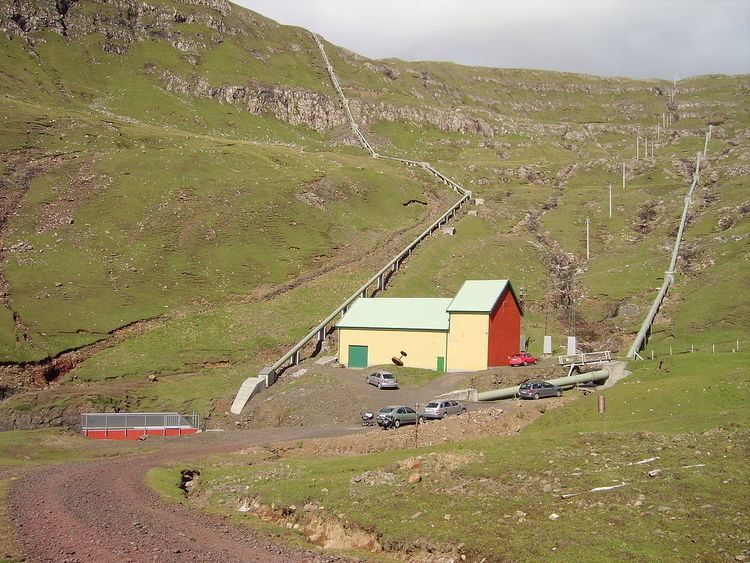 | ||
Energy in the Faroe Islands is produced primarily from fossil fuels, with further contributions from hydro and wind power. Oil products are the main energy source, mainly consumed by fishing vessels and sea transport. Electricity is produced by oil, hydropower and wind farms, mainly by the SEV, which is owned by all the municipalities of the Faroe Islands. The Faroe Islands are not connected by power lines with continental Europe, and thus the archipelago cannot import or export electricity.
Contents
Overview
Per capita annual consumption of primary energy in the Faroe Islands was 67 MWh in 2011, almost 60% above the comparable consumption in continental Denmark. After taking a dip in the early 1990s the electricity production in the Faroe Islands has steadily been on the rise since then, going from 174,422 MWh in 1994 to 314,409 MWh in 2015. Wind power was introduced in 1993, producing as little as 423 MWh at first, but rising to 55,789 MWh by 2015. The energy sector employed 154 people or 0.6% of the islands' total workforce as of November 2015.
Electricity
The islands have 6 hydroelectric plants, 4 diesel plants and several wind power plants with a capacity factor above 40%. In 2014, the DKK 180 million 12MW Húsahagi wind farm with Enercon turbines became operational near Torshavn and increased wind capacity from 6.6 to 18.6MW; this decreased oil consumption by 8,000 ton (approximately 4M€) per year. A 2.3MW 700kWh lithium-ion battery at €2 million near Húsahagi became operational in 2016.
Planners also consider converting the existing hydropower to pumped-storage hydroelectricity. Tidal power and Thermal energy storage solutions are also being considered, as the islands have a goal of 100% green electricity production by 2030.
The main electricity grid on the Faroe Islands has the highest voltage of 60 kiloVolt, of which there is 90 km overhead wire and 6 km cable. The 20kV system is 460 km and reaches most towns in the main islands, whereas the 10 kV system covers the connected outlying islands, and Torshavn.
Suðuroy has its own grid with 20 and 10 kV, and is powered by the 3.3 MW Botnur power plant and 8 MW diesel at Vágur and 2 MW at Trongisvágur.
Fugloy, Hestur, Mykines, Skúvoy and Stóra Dímun are not part of the main grid, and are electrified through their own fossil fuel powerplants.
Due to extreme weather conditions and its lack of interconnections, the Faroe Islands experience one to three total blackouts annually, a ratio higher than that of continental Europe. The municipality-owned company SEV is the main electricity supplier in the Faroe Islands with 97% of the total production, with private producers supplying the rest.
Statistics
In 2014 50.8% of the electricity production of SEV in the Faroe Islands came from green energy like hydro (mostly Eiði and Vestmanna) and wind, while 49.2% was produced by the thermal power plants, which was 12.4% less than in 2013.
Total annual production: 305.4 GWh (2014) of which the production of thermal, hydropower and wind power was:
Government energy policy
The Faroe Islands have set a goal of producing their entire electrical energy needs from renewable energy sources by 2030. Since energy consumption has been rising steadily during the last few decades, the Ministry of Trade and Industry has conducted a study for the future development of electricity production projects. Apart from the development of new hydropower plants and wind farms, the study proposes the investigation of the possibility to produce electricity from LNG and biogas. The University of the Faroe Islands has undertaken research into the feasibility of tidal power at several sites which have a high energy potential, leading the Ministry of Trade and Industry to consider tidal power as a possibility. The privatisation of electricity production was not promoted, although consideration was given to introducing competition and transparency into electricity production.
